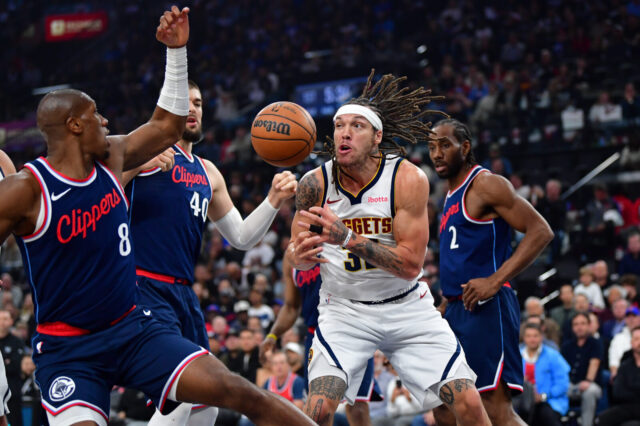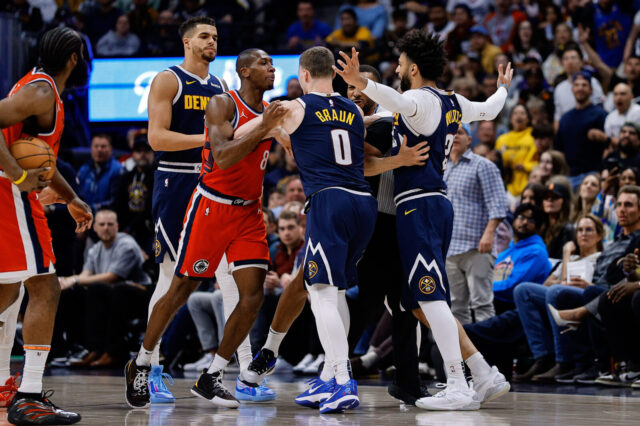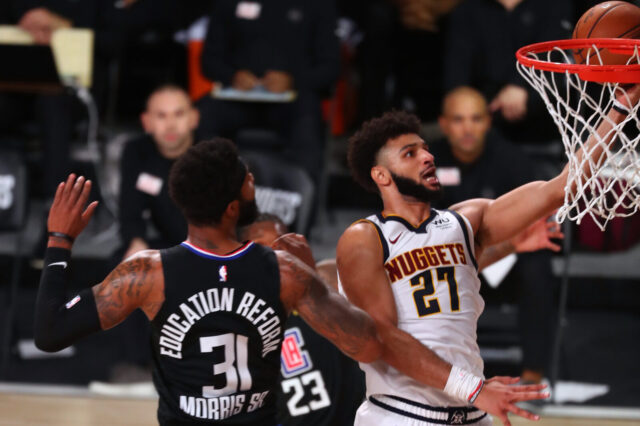The Denver Nuggets won 9 of their last 12 games heading into the all-star break, the best 12-game stretch of their season. They’ve managed to rack up some of their best signature wins of the season in that span including wins at Milwaukee and home wins against the Thunder, Spurs, and Warriors. Yet, despite the winning streak, there’s still a somewhat ominous cloud hanging over the heads of Nuggets fans (and over the head of the team’s coach) as they watch their team outpace and outgun the opposition:
The team has shown no signs of stopping the pick-and-roll (PnR).
Over the last 12 games, the Nuggets have ranked 27th in defensive efficiency and 2nd in offensive efficiency. That evens out to a slight net positive but the concerns are very evident, especially as more and more teams start to target Denver’s weakness in the PnR. As the Nuggets enter the most brutal six-week stretch of their season, they’ll have to figure out how to improve this vital part of their game if they want to stay afloat in the western conference playoff hunt.
Let’s take a closer look at where the team is breaking down in this week’s spotlight.
This content is no longer available.
Jokic slow recovery in PnR
There are three key players involved in defending the PnR. The on-ball defender is charged with fighting through the ball screen quickly enough to negate the need for a switch. The big defending the screener must either contain the ball handler or deter them from turning the corner before recovering back to the roll man. Lastly, there’s the help side defenders who must cover for both guys before recovering back to take away the kickout three-point shooter.
If a team has elite perimeter defenders who can fight through screens and contest passes and shots out of the PnR, then the need for an elite rim protector isn’t as urgent. Likewise, if a team has an elite rim protector, the need for elite perimeter defenders is less urgent. Denver has neither, and as a result their defensive effectiveness relies quite heavily on their ability to work on a string. Unfortunately, the Nuggets PnR defense often comes untethered.
The first part of the equation is the team’s center, in this case, Nikola Jokic. Jokic doesn’t deter anyone from entering the paint since he isn’t an intimidating force or shot blocker, so his most important responsibility in PnR defense is to contain the ball long enough to allow the on-ball defender to recover or force the ball-handler into a low percentage attempt.
Far too often, Jokic is too slow recovering back to his man once the on-ball defender gets through the screen. In the clip above, the screener does a very poor job of forcing Jamal Murray out of position with the screen so Murray is able to recover immediately without losing any ground. However, Jokic holds the show for a second too long, effectively creating a road block for Murray. Jokic needs to read the situation quicker and clear the area for Murray to guard the ball handler one-on-one.
Switching the screen is hardly an option against teams with fast guards or ball-handling bigs. The Milwaukee Bucks featured both and the result against Denver was a layup line out of 4-5 PnR’s. This is one fear the Nuggets coaching staff must have about a playoff series – once a team finds a weakness, they’ll go back to the well over and over until their opponents figure out how to stop it. Denver’s weakness on defense is obvious and over the last few weeks, they have not been able to get consistent stops when opponents can force Jokic to switch out onto the ball or contain in space.
Darrell Arthur provides a good example of just how quickly a big has to react in order to properly stymie the PnR. In the clip below, Arthur shows on the screen but his recovery onto a rolling Clint Capela begins the exact moment Chris Paul goes into his passing motion. There’s no wasted movement or hesitation. Once recovered, Arthur makes another great reaction and helps fully outside of the restricted area before Luc Mbah-a-Moute finishes his second dribble.
Like Jokic, Arthur isn’t a rim deterring presence inside so he makes up for it with quick reads and rotations. Jokic has more length than Arthur but he will eventually have to speed up his rotations if he wants to stay on the court in a playoff series against teams like the Houston Rockets and Oklahoma City Thunder, two teams that can target him every time down the court.
As a footnote, one reason I suspect Jokic does not contain the PnR well is because it takes a tremendous amount of energy to execute properly. With Jokic taking on duties as the focal point on offense, he might not have the stamina to be a two-way player for 35 minutes every night. Even Darrell got fatigued quickly against Houston trying to make these rotations every time down court, as evinced by the mountain of offensive rebounds that Capela was able to pull in over fatigued defenders.
Denver’s on-ball defenders offer little help
As bad as Jokic is at containing in space, Denver’s back court is nearly equally as bad at forcing the ball-handler away from the path of least resistance. This is where the PnR defense begins. Strong on-ball defenders can either steer their opponent away from the screen or force them into a wide route, halting their momentum and buying an extra split second for their teammates to hold position. The Nuggets not only fail to make things difficult for the ball-handler, they often fall asleep at the exact moment they need to be their most focused and intense.
Plays like the one above happen far too frequently, as do plays when the on-ball defender takes a half second too long to get through the screen, forcing Jokic or another Denver big to contain the ball for longer than they are capable. Because of that, Denver has taken to switching screens, even in situations when those switches force Jokic out onto the perimeter against quicker guards. And on rare occasions when Denver’s bigs do a good job of containing the ball, Denver’s guards routinely fail to box out on the offensive glass.
What’s most alarming is how this trend of switching but then giving up the putback remains constant among all of Denver’s guards, including the ones who aren’t even in the rotation. Whether it’s the starting guard or the end of bench guard, good teams execute these types of tiny details. Denver doesn’t have a single guard who routinely executes these types of plays properly.
Plumlee, Millsap, and help side
The third leg of PnR defense is the help side provided by the three players not directly involved in the screen and here is where Denver has sorely missed both Mason Plumlee and Paul Millsap. The three most important ingredients for proper help side when defending the PnR are awareness, timing, and hustle. Plumlee never quits on a play on defense and over the last two months of his season (before leaving the rotation due to a calf strain) his hustle level had been off the charts.
Above, Jokic and Gary Harris get beat off of a nice pindown and roll action that mimics a PnR and Marquese Chriss gets what ought to be a wide open dunk. Fortunately for Denver, Plumlee recognizes the breakdown immediately and sprints over to contest the shot. Mistime the rotation and Plumlee risks leaning into a poster. Instead, Plumlee saves what appeared to be an automatic two points for the Suns.
While Plumlee is very good at this role, Paul Millsap is among the best in the entire NBA. His focus and anticipation on the defensive end is on par with players like Draymond Green. He’s always in a heightened state of awareness, lasered in on what’s happening at all five spots on the court. He puts pressure on the ball-handler to make perfectly timed passes in the PnR; anything short of that and he’ll eliminate the shot at the rim or the kickout. Just look at his timing on these bucket-saving blocks.
Questions remain about how much the return of Plumlee and Millsap will disrupt the absurdly efficient offense that the Nuggets have cultivated over the last three weeks but there is no question that their presence will elevate the defense. If Denver can maintain their high-powered offensive attack while simultaneously shoring up their defense, they’ll become one of the most dangerous teams in all of the NBA.
This content is no longer available.
Denver struggles in other areas besides the PnR. Even on basic actions, the Nuggets get mixed up in rotations, often sending multiple guys to the same closeout. In the clip below, the Nuggets first give up a wide open curl to the rim that goes unnoticed before eventually sending three guys to stop a drive while leaving an open shooter in the corner.
Those types of errors stick out like a sore thumb but on rare occasions that Denver forces opponents to use up the shot clock, they struggle with lapses of judgement late into the shot clock. Here, Will Barton does a great job containing the ball but then reaches in for a near-pointless swipe at the ball and gives up an open three-pointer. This is basic decision making in the modern NBA. TJ Warren is an excellent mid-range player but a late shot-clock contested pull-up two-pointer is something you live with. An open catch-and-shoot three pointer from the top of the key is not. Bad gamble.
Trey Lyles also pops up frequently on the missed rotations list. Below, the Rockets put Denver into what is known as a “Spain PnR,” meaning they use Capela to set the ball screen before hitting Capela’s defender with a back screen. These types of actions require a lot of communication and effort on the defensive end. In the example, Malik Beasley makes a big effort to tag the roller and close out on the shooter. Lyles was probably responsible for the shooter but Beasley notices Lyles’s late recognition and covers for him. To make matters work, Torrey Craig notices a second missed rotation by Lyles and releases to the corner to contest a three-pointer.
This content is no longer available.
One of the big questions facing Michael Malone and his staff in the coming weeks will be how to handle the starting lineup. Over the last seven games, the Nuggets have started Murray, Harris, Barton, Wilson Chandler, and Jokic. They’ve won six of those seven games and have a +8.1 net rating over that stretch despite getting outscored by 24 points against the Houston Rockets. Even more incredible is that that unit has outscored opponents by 24 points in first quarters of their six wins.
With Plumlee set to return, Malone will at least consider moving him back into the starting lineup in place of Chandler. Denver experimented with that lineup for three of the four game prior to Plumlee’s injury and outscored opponents by 47 points with that lineup for a lineup net rating of +32.6!
Then there’s the question of Millsap’s return. While Barton seemed to be one of the keys to unlocking the Jokic-Plumlee combination, Chandler was part of Denver’s early season starting lineup that somehow remains Denver’s most-used 5-man lineup to date despite the fact that one of the five players in that group – Paul Millsap – has missed the last 44 games! The Nuggets played 224 minutes with Murray, Harris, Chandler, Millsap, and Jokic and have a +12 net rating, the 7th-best net rating of any 5-man lineup in the entire NBA to log at least 224 minutes.
However, the addition of Barton in Chandler’s spot has worked incredibly well over the last month of the season. Will Malone elect to replace Chandler with Barton once Millsap returns? These are tough questions to answer and Denver doesn’t have a lot of time to tinker with different looks. Fortunately, all options seem pretty good, at least as far as starting units are concerned.


